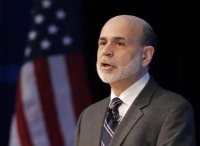FOMC声明 日本時間 2013/6/20 (木) 03:00ごろ発表
Release Date: June 19, 2013
For immediate release
Information received since the Federal Open Market Committee met in May suggests that economic activity has been expanding at a moderate pace. Labor market conditions have shown further improvement in recent months, on balance, but the unemployment rate remains elevated. Household spending and business fixed investment advanced, and the housing sector has strengthened further, but fiscal policy is restraining economic growth. Partly reflecting transitory influences, inflation has been running below the Committee's longer-run objective, but longer-term inflation expectations have remained stable.
Consistent with its statutory mandate, the Committee seeks to foster maximum employment and price stability. The Committee expects that, with appropriate policy accommodation, economic growth will proceed at a moderate pace and the unemployment rate will gradually decline toward levels the Committee judges consistent with its dual mandate. The Committee sees the downside risks to the outlook for the economy and the labor market as having diminished since the fall. The Committee also anticipates that inflation over the medium term likely will run at or below its 2 percent objective.
To support a stronger economic recovery and to help ensure that inflation, over time, is at the rate most consistent with its dual mandate, the Committee decided to continue purchasing additional agency mortgage-backed securities at a pace of $40 billion per month and longer-term Treasury securities at a pace of $45 billion per month.(量的緩和850億ドル維持) The Committee is maintaining its existing policy of reinvesting principal payments from its holdings of agency debt and agency mortgage-backed securities in agency mortgage-backed securities and of rolling over maturing Treasury securities at auction. Taken together, these actions should maintain downward pressure on longer-term interest rates, support mortgage markets, and help to make broader financial conditions more accommodative.
The Committee will closely monitor incoming information on economic and financial developments in coming months. The Committee will continue its purchases of Treasury and agency mortgage-backed securities, and employ its other policy tools as appropriate, until the outlook for the labor market has improved substantially in a context of price stability. The Committee is prepared to increase or reduce the pace of its purchases to maintain appropriate policy accommodation as the outlook for the labor market or inflation changes. In determining the size, pace, and composition of its asset purchases, the Committee will continue to take appropriate account of the likely efficacy and costs of such purchases as well as the extent of progress toward its economic objectives.
To support continued progress toward maximum employment and price stability, the Committee expects that a highly accommodative stance of monetary policy will remain appropriate for a considerable time after the asset purchase program ends and the economic recovery strengthens. In particular, the Committee decided to keep the target range for the federal funds rate at 0 to 1/4 percent and currently anticipates that this exceptionally low range for the federal funds rate will be appropriate at least as long as the unemployment rate remains above 6-1/2 percent, inflation between one and two years ahead is projected to be no more than a half percentage point above the Committee's 2 percent longer-run goal, and longer-term inflation expectations continue to be well anchored. (金利据え置き、前回と同じ)In determining how long to maintain a highly accommodative stance of monetary policy, the Committee will also consider other information, including additional measures of labor market conditions, indicators of inflation pressures and inflation expectations, and readings on financial developments. When the Committee decides to begin to remove policy accommodation, it will take a balanced approach consistent with its longer-run goals of maximum employment and inflation of 2 percent.
Voting for the FOMC monetary policy action were: Ben S. Bernanke, Chairman; William C. Dudley, Vice Chairman; Elizabeth A. Duke; Charles L. Evans; Jerome H. Powell; Sarah Bloom Raskin; Eric S. Rosengren; Jeremy C. Stein; Daniel K. Tarullo; and Janet L. Yellen. Voting against the action was James Bullard, who believed that the Committee should signal more strongly its willingness to defend its inflation goal in light of recent low inflation readings, and Esther L. George, who was concerned that the continued high level of monetary accommodation increased the risks of future economic and financial imbalances and, over time, could cause an increase in long-term inflation expectations. (2名反対)
FRB: Press Release--Federal Reserve issues FOMC statement --June 19, 2013
http://www.federalreserve.gov/newsevents/press/monetary/20130619a.htm
日本時間 3:30ごろ、バーナンキ議長会見

「緩やかな回復を見込む。財政政策からの逆風が見込まれる。」
「雇用改善や住宅市場回復が消費者信頼感を引き上げた。」
「多数のメンバーは出口戦略の仮定でMBSの売却に否定的。」
「失業率6.5%への低下、自動的に利上げにつながるわけではない。」
「資産買い入れ終了と金利引き上げの間にかなりの期間あると想定。」
「資産買い入れペースの縮小、経済が予想通り推移すれば年内となる公算と予想。」
「資産買い入れの終了、経済見通し正しければ来年半ばまでに行われる見通し。」
「資産買い入れ縮小に決まった計画はない。経済の状況次第。」
「米国債の利回り上昇は見通しが楽観的見方やFRB政策に対する認識が一因。」
「今後の去就についてはコメントせず。」
「失業率の基準値を調整する可能性も。」
「資産購入終了には依然として距離がある。 」
「必要なら更なる支援も。」
「メンバーの大多数は15年末も低金利を予想。」
「低過ぎるインフレは問題。 インフレが目標下回っていることをFRBが懸念していないというのはまったくの誤り。」
市場予想どおりの実質ゼロ金利据え置き、
QE3実施規模の据え置き、
「異例の低金利」の具体的な解除条件据え置き、
と、おおむね予想どおりの結果となりましたが、
反対の委員が前回の1名に対して今回は2名となりました。
その後のバーナンキ議長会見では、
今までとうって変わって、
希望があちこちに垣間見える内容でした。
長く続いた夜の、夜明けがようやくうっすらと見えてきた感じです。
ファンダメンタル分析的に考えれば、
量的緩和の解除方向
→ドルをジャブジャブ供給してる蛇口を絞る
→株は下落、ドルは上昇
となるように思えます。
これを受けてマーケットはどのように反応したのでしょうか。
↓のチャートを見る前に1分間想像してみてください。
・NYダウ の値動き → 上昇?下落?
・ドル円 の値動き → 上昇?下落?
・ユーロドル の値動き → 上昇?下落?
・ユーロ円 の値動き → 上昇?下落?
・ポンドドル の値動き → 上昇?下落?
・ポンド円 の値動き → 上昇?下落?
・原油 の値動き → 上昇?下落?
・金 の値動き → 上昇?下落?
5分足 以下のチャートでは21:00が日本時間03:00
ダウは暴落、
純粋なドル高→その反作用で原油・金暴落、
クロス円の暴落を見ても、リスク選好モードというわけではない。
クロス円が伸びないと、ドル円の上値も限定的。ドル円にとっての真の上昇トレンドではない。
政策金利一覧

